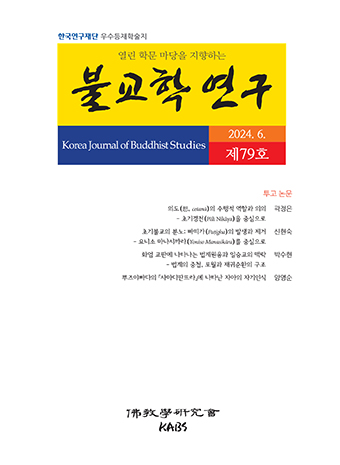Abstract
References
Sorry, not available.
Click the PDF button.
Information
This paper explores types and ways of the enlightenment viewed in the Huayan thoughts. First, the Flower Ornament Sutra’s view is different from those of the others’. The reason why people are called the sentient beings in the Sutra is not because they are naturally polluted but because they are just named the sentient beings as their natural wisdom is temporarily covered with their pollutions. The enlightenment generally means the fundamental changes of the states from the sentient beings based on the pollutions toBuddhas based on the wisdom. But in the view of the Huayan thoughts, there is no switch from the former to the latter, for one who has been a Buddha ‘already’ begins to be aware of oneself as a Buddha and just manifests oneself in the real world. It is called ‘Being a Buddha’ in the Huayan thoughts. The next is why the Huayan thoughts see the enlightenment in that way. Itbasically comes from the structure of the Sutra. The Sutra describes the world of the Buddha’s initial enlightenment itself. The word of ‘initial’ means the time when the Buddha had enlightened for the first time, and also means ‘the beginning of that there is no beginning nor ending’. It has the same meaning as the One Mind is set outside the Nine Periods of Times: the former is outside the latter, although, the former is corresponding with each of the latter. In this point, the view of time in the Sutra or in the Huayan is different from those of the others’. This paper explains these Huayan’s different views and time with focus on the Sutra and masters’ annotations on the Sutra.
본 논문의 주제는 화엄사상에서 생각하는 깨달음의 유형과 방식은 무엇일까 하는 점이다. 첫 번째, 『화엄경』의 視點은 다른 경전들의 視點과 다르다. 『화엄경』에 있어서 중생이 중생으로 불리는 이유는, 그 중생이 번뇌를 본질로 하고 있기 때문이 아니라 본질인 지혜가 번뇌에 의해 일시 가려져 있는 상태를 중생이라고 부르는 것에 불과하다. 흔히 말하는 ‘깨달음’은 번뇌를 토대[依持]로 하는 중생의 상태가 지혜를 토대로 하는 붓다의 상태로 근본적인 전환을 이룸을 말한다. 그런데 화엄의 관점에서 중생이 붓다로 전환한다는 사태는 발생하지 않으며, ‘이미’ 붓다인 중생이 붓다임을 자각하고 붓다로서의 상태를 현실에 구체화시켜 현현할 따름이기 때문이다. 그리고 그것을 화엄에서는 ‘成佛’이라고 표현한다. 두 번째, 그렇다면 화엄사상이 그렇게 바라보는 이유는 무엇인가? 그것은 근본적으로 『화엄경』의 구조에서 전제되어 있는 것이다. 『화엄경』은 붓다의 ‘始成正覺’의 세계 자체를 설한다. 이때의 ‘始’는 붓다가 처음 깨달은 그 때를 의미하면서, 동시에 ‘無始無終의 始’라는 의미이다. 시간적 점차로서의 구세(九世)의 바깥에 ‘一念’을 설정하고 있는 것은 그러한 의미이다. 그 일념은 구세의 바깥에 있는 것이지만 동시에 구세의 모두에 대응하는 시간이기도 하다. 이 점에서 『화엄경』 혹은 화엄이 말하는 時點은 다른 경전이 말하는 時點과 차별성을 지닌다. 본 논문에서는 이 화엄이 가지는 視點과 時點의 다름을, 『화엄경』 혹은 그것을 주석하는 화엄가들이 어떻게 설명하고 있는가에 초점을 두고 검토하였다.
Click the PDF button.
- Publisher :Korean Association of Buddhist Studies
- Publisher(Ko) :불교학연구회
- Journal Title :Korea Journal of Buddhist Studies
- Journal Title(Ko) :불교학연구
- Volume : 54
- No :0
- Pages :213~236


 Korea Journal of Buddhist Studies
Korea Journal of Buddhist Studies






